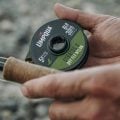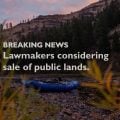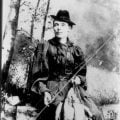Branding Native Fish: A Critically Important Step

Editor’s Note: This is the twelfth article in our series on fly fishing conservation. This series appears with the support of Epic Fly Rods.
Branding is a huge part of our daily lives. It’s everywhere you look, even though you don’t always notice it. Branding can be blatant or subliminal, absolute or suggestive, visual or audible, and words or images. Branding is a critically important tool when it comes to gaining support for something. This includes products, services, entertainment, and even causes. Whether it is a name, logo, motto, slogan, jingle, character, or some combination of the above, put it out there enough and people will take notice.
The most successful companies in the world such as General Motors, McDonald’s, Coca-Cola, and Anheuser-Busch, spend millions of dollars a year on branding. Slogans such as “Tested Tough,” a branding message used by Ford Motor Company are guarded registered trademarks. In 1974 Burger King came out with the slogan “Have it Your Way,” to differentiate itself from industry leader McDonald’s. I don’t like onions or excessive condiments, so it got my attention.
Government agencies use branding as well. Consider Smokey the Bear. Created by the U.S. Forest Service in the early 1940s, it is said to be the longest running public service advertising campaign in U.S. history. Smokey was so popular at one time that the U.S. Postal Service created a unique zip code just to handle his fan mail. Did anything do more than Smokey’s message, “Only you can prevent forest fires,” to educate the masses in regard to wildfire prevention? Then there was Woodsy Owl, created by the USFS in the 1970s, who said, “Give a hoot, don’t pollute,” later modernized to “Lend a Hand – Care for the Land!”
Conservation organizations jumped on the branding bandwagon as well with campaigns such as “The Crying Indian,” sponsored by Keep America Beautiful, a nonprofit organization dedicated to reducing litter in the United States. Along with Woodsy Owl, KABs 1970s “Get Involved now. Pollution hurts all of us” slogan did more to draw attention to litter and other forms of pollution, and that we humans were to blame for it, than anything before or since has done.
Closer to home, Trout Unlimited was responsible for what was arguably the most successful branding campaign in the history of fishing, “Catch and Release.” While TU did not invent the concept or coin the phrase, they did bring the message of releasing fish front-and-center and made it a battle cry for conservation-minded anglers across the nation for several decades. Even with TU backing off in favor of a habitat-centric message, many anglers still adhere to this important message.
Keep Fish Wet, formerly #KeepEmWet, a slogan and the name of the organization that promotes proper fish handling, has helped change in a positive way how we handle the fish we catch. It has also influenced the media in regard to what is and is not an acceptable fish photograph. As a result of their efforts, many fly fishing media outlets no longer run pictures of fish that are being mishandled, which is good for fish and by default fishing.
And while more about loons than fish, at least directly, Fish Lead Free, a Northeast regional multiple agency/organization effort has done a lot to promote the use of non-lead weights and jigs in fishing. It also helped gain support for legal restrictions, although not outright prohibitions, in regard to lead terminal tackle in Maine, Massachusetts, New Hampshire, New York, and Vermont.
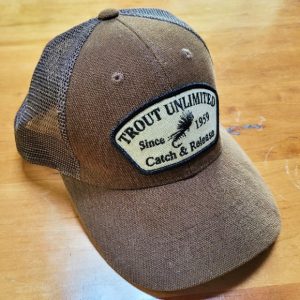
One of the most successful branding campaigns in fly fishing. – photo by Bob Mallard
When we formed Native Fish Coalition, our goal was to try to change how folks view aquatic ecosystem conservation. We understood that we need to go beyond clean water and healthy riparian areas and adopt a more holistic approach that includes fish. We also realized that we would need to go beyond anglers as we are too small of a demographic to influence the changes needed. And in some cases, unfortunately, we are a primary reason our aquatic ecosystems are in trouble.
For fish conservation to be effective it needs to include all fish not just gamefish. Most importantly, we need to focus on native fish. Naturalized nonnative fish are not the sign of a healthy ecosystem, are in fact a sign of an unhealthy ecosystem, and often the reason that native fish are depressed or absent. Nowhere is this truer than our coldwater aquatic ecosystems where nonnative and stocked fish are the rule not the exception.
In most cases, the models in regard to aquatic ecosystems and fish conservation have been in place for decades. General conservation groups and watershed associations are typically focused on clean water and healthy riparian areas, but not fish. Fish conservation groups are usually species-centric and gamefish focused. Non gamefish are dangerously underrepresented yet they are a critically important component of a healthy aquatic ecosystem.
Getting non-fish conservation groups and non-anglers involved in fish conservation will be critical to the success of big picture aquatic ecosystem conservation. Without their support it will be, and has been, an uphill battle. But this will not be easy as most non-fish groups and non-anglers have historically been reluctant to challenge sporting groups and state fish and game agencies. For this to work both will need to make some concessions.
While salmon, steelhead, striped bass, redfish, tarpon, and bonefish conservation are native-focused; trout conservation, figuratively speaking as it includes char and salmon, is as much “wild” centric as it is native centric. And this model has been in place for half a century. Longer if you count what federal and state government agencies were doing before the public got involved. Changing how we view coldwater ecosystems and trout is clearly NFCs biggest challenge.
Waters such as the fabled Batten Kill in Vermont, Beaverkill River in New York, Letort Spring Run in Pennsylvania, Madison River in Montana, and Henry’s Fork in Idaho are primarily nonnative fisheries. In fact, most of the famous and popular trout rivers in America are nonnative fisheries. And many waters such as the San Juan River in New Mexico, Green River in Utah, Lees Ferry in Arizona, Bighorn River in Montana, and White River in Arkansas are not even natural trout fisheries.
When it comes to conservation, trout anglers have been taught for decades that stocking is bad, and that wild trout, char, and salmon are good regardless of where they come from. In fact, in many cases, stocking is only viewed as a problem when it is being done over wild trout. These positions are prevalent in much of our trout fishing, advocacy, media, tackle, and outreach.
In addition to taking a big picture view of aquatic ecosystem conservation that includes fish as well as habitat, NFC wants to change the emphasis of fish conservation from species-specific to all species and from wild to native. To do this, we looked to others who have been successful in regard to changing how folks view things. Pollution, litter, wildfires, recreational harvest of fish, fish handling, and lead tackle are all examples. In all cases, branding played an important role.
Using the word “native” as part of our name was NFC’s first step toward branding native fish. The term native, usually accompanied by the word “wild,” is included in our Mission, About, and Goal statements, and we explain why native fishes matter on our website at the national and individual state level. Our name and logo are used throughout our website and social media, as well as our brochure, business cards, and event banners. NFC also sells a wide range of “native fish” logo schwag.
In instances where nonnative fish have become more popular with anglers than native fish, as is the case with regard to brook trout and redeye bass, NFC is working to brand the native alternative. Ditto for at-risk native fish species. To do this, we have developed a series of decals, bumper stickers, t-shirts, and other schwag items such as wading belts, dog collars, and key fobs that promote native fish and specific species.
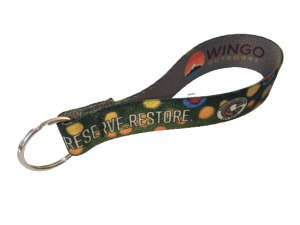
Native Fish Coalition key ring
NFC has also been very active in regard to informational signage pertaining to wild native fish. This includes signs reinforcing laws and regulations; or denoting special programs; the presence of unique, rare, at-risk, or endangered species; and threats to native fish such as manmade rock dams. This too is a form of branding and these signs are seen by not only anglers, but anyone else who happens to be in the area. In fact, some of the positive feedback we have received has come from non-anglers.
As a relatively new organization bucking a long-standing and deeply entrenched status quo and fighting for acceptance, support, membership, and funding, there are a lot of things NFC can’t do. But the one thing we can do is brand native fish. This will help recruit people to the cause, influence the media and industry toward a more native-centric position, put pressure on the powers that be to do the right thing, and make it easier for others trying to do the same thing we are by increasing awareness.
In roughly 5 years, NFC has sold over 2,000 decals, 250 bumper stickers, 200 patches, 75 pins, 1,000 hats, 125 t-shirts, 350 miscellaneous gear items, 75 signs, and 10 pieces of artwork, all of which brand native fish. In total, we have sold more than 4,000 native fish branded items, most of which are seen by multiple people. NFC has also sold over 220 books that emphasize native fish over nonnative fish. In addition, we have posted over 700 information signs pertaining to native fish that have been viewed by thousands of people.
Seeing decals and bumper stickers with the term “native fish” on vehicles in traffic, parking lots, businesses, boat launches, and trailheads is powerful. It gets the native fish message beyond anglers, and into the general public. The same holds true for hats and T-shirts which are not only worn in the field, but during day-to-day life including work, shopping, dining, events, and entertainment, as well as posts on social media.
While it may look like a self-serving promotion on the part of NFC to some, our intent has always been to brand native fish more than Native Fish Coalition. But to brand the former you have to have the latter. Otherwise it is just a message without a call to action. For over 20 years the license plate frame on my truck has said “CATCH AND RELEASE WILD TROUT.” Like most, I am a product of what I have been exposed to. But that is changing, and branding native fish is a big part of the reason why.









